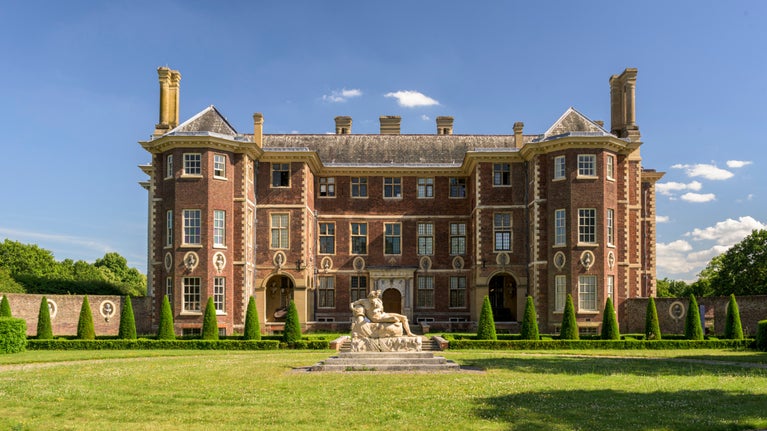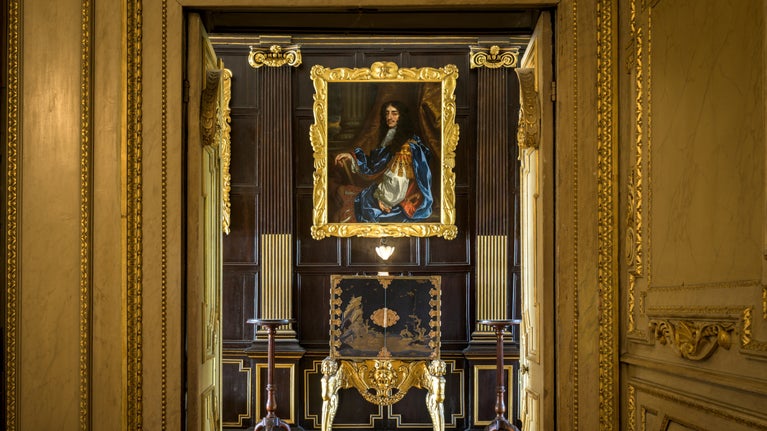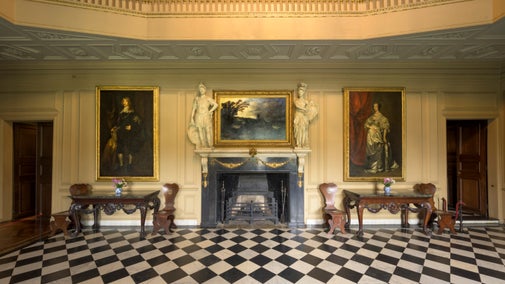
Ham House and Garden's collections
Explore the objects and works of art we care for at Ham House and Garden on the National Trust Collections website.

Gifted to William Murray by King Charles I in 1626, Ham House was transformed by William and his wife Catherine, and later their daughter and heir Elizabeth. Surviving the English Civil Wars and Parliamentary rule, and home to Elizabeth and her descendants for almost three centuries, the house you see today is a rare survivor of one of the great Stuart houses.
Please note, the house is currently closed for winter conservation work and reopens on 14 February 2026. The gardens, café, shop and second-hand bookshop are open as usual during this period. Thank you for your understanding and support.
Originally built in 1610, the interiors of Ham House as you see them today are the creation of loyal courtiers William and Catherine Murray, and their tenacious daughter Elizabeth, later Duchess of Lauderdale.
As a boy, William was educated with the young Charles I, and they remained close friends as adults. William was gifted the lease of Ham House and its estate by the King in 1626.
Between 1637-39, William and Catherine embarked on a series of lavish decorative alterations to the house. These changes were designed to reflect their taste, their favoured status as friends of the King and Queen, and their position as key members of the royal court.
Unfortunately for this important royalist family, civil war broke out in 1642 between King Charles I and Parliament. As a Royalist and close friend to the King, William had no choice but to help fight against the Parliamentarians, leaving his wife Catherine and their young family to hold the fort at Ham House.
Fought primarily over the balance of power between the Crown and Parliament, the Royalists ultimately lost the wars and Charles was captured. He was later tried for high treason and beheaded in 1649. Charles’s son came to an agreement with the Scots and was crowned Charles II of Scotland. However, his attempts to take back the throne of England failed and he fled to the continent. William remained in exile, and Catherine and their daughter Elizabeth remained at Ham to protect it from confiscation by Parliament.

Catherine died in 1649 and Ham House was left in the capable hands of Elizabeth, who was supported by her first husband Lionel Tollemache.
In 1653, Cromwell was installed as 'Lord Protector' of the new Commonwealth. By maintaining good relations with Cromwell during his rule, Elizabeth was able to keep control of Ham during the interregnum, the period between the death of Charles I and the Restoration of Charles II. At the same time, Elizabeth also secretly supported efforts to return the Stuarts to the throne, carrying secret letters to the continent and sharing recipes for invisible ink with her collaborators.
After the Restoration of the crown in 1660, Elizabeth was granted a pension of £800 per annum by the new King Charles II (around £160,000 today). She was also confirmed as Countess of Dysart in her own right. These lavish rewards suggest that Elizabeth was an important but secret supporter of the king during his exile.
With King Charles II on the throne and Royalists once again in favour, Ham House re-emerged as a place of power, entertaining, and extravagance.

In 1672, Elizabeth married for the second time. Her new husband, the powerful Earl of Lauderdale, was a key member of King Charles II's inner cabinet. Sharing a love of power and decadence, together they made a dynamic Restoration court couple.
After their marriage, they were created Duke and Duchess of Lauderdale. To match their high status, they transformed Ham House into one of the grandest Stuart houses in England.
They extended the house to the south to create more rooms and employed the best craftspeople to provide the finest interiors, furniture, and art. Many of these craftspeople had also worked on royal palaces and collections. They also developed the formal gardens surrounding the house, including a private garden for Elizabeth and a showpiece walled kitchen garden.
After Elizabeth’s death in 1698, Ham House was home to her descendants from her first marriage, the Tollemache family, for the next 250 years.
In 1948, Sir Lyonel Tollemache generously gifted Ham House to the National Trust. With only a few alterations made during the 1740s and 1890s, it's a rare survival of 17th-century luxury and taste.

Explore the objects and works of art we care for at Ham House and Garden on the National Trust Collections website.
Among the rare collection of cabinets at Ham House in Richmond, discover fashionable 17th-century statement pieces, strong boxes and secret hiding places.

Take a look behind the scenes and discover the work that goes into keeping this special place looking its best.

Explore the well-preserved interiors of one of the grandest Stuart houses in England, created to impress in the 17th-century by the Duchess of Lauderdale and her husband the Duke.

Learn about people from the past, discover remarkable works of art and brush up on your knowledge of architecture and gardens.
